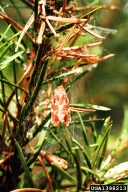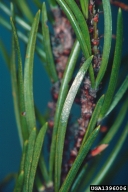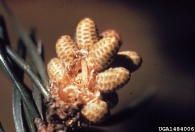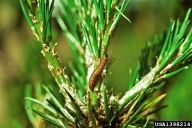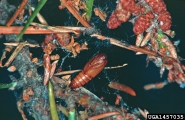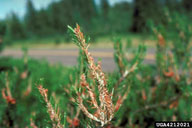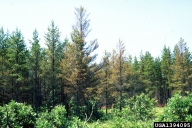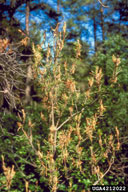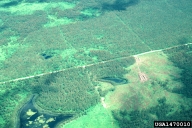Jack pine budworm
Choristoneura pinus pinus Freeman (Lepidoptera: Tortricidae)
Orientation to pest
Jack pine budworm, Choristoneura pinus pinus Freeman, is closely related to eastern spruce budworm, Choristoneura fumiferana (Clemens), and is part of a complex of eight closely related species (see Lumley et al. 2010, 2011 below). Jack pine budworm is a native North American moth found in eastern Canada, westward to Alberta and in the northeastern and north central United States. Its larvae feed various pines, especially jack (Pinus banksiana Lamb.) and red (Pinus resinosa Sol. ex Aiton) pine. Adults fly in mid-to-late summer and lay their eggs in clusters (about 40) on needles. Eggs hatch and the young larvae, without feeding, create hibernaculae under the bark scales on tree trunks or limbs, or between needles. They then molt to second instars and overwinter. In the spring of the following year, larvae emerge near the time when staminate flower buds begin to swell. Staminate flowers are usually the larvae's first food, and thereafter most larvae move to new foliage, where they feed and develop. Needles are clipped and webbed together by older larvae, and needles are only partially consumed. Pupation occurs among the needles or webbed shoots. Feeding of jack pine budworm usually does not kill attacked trees, but may cause top killing and deform the tree, reducing quality of logs for lumber purposes. During outbreaks, younger trees may be killed outright. For further information see Van Driesche et al. (1996).
Hosts commonly attacked
Jack pine budworm larvae feed on various pines, but especially jack (P. banksiana) and red (P. resinosa) pine.
Distribution
This moth is found in Canada throughout the range of jack pine, from the Maritimes west to Alberta. In the United States, it is found in the northeastern and north central parts of the country, from New England to the Great Lakes states.
Images of jack pine budworm
| Figure 1. Adult of jack pine budworm, Choristoneura pinus pinus | Figure 2. Hatched egg mass (shiny area on central needle) of jack pine budworm | Figure 3. Young larvae of jack pine budworm, feeding on male flower of host plant |
| Figure 4. Mature larva of jack pine budworm | Figure 5. Pupa of jack pine budworm, in area webbed by larvae | Figure 6. Webbing and feeding on shoots of host by jack pine budworm larvae |
| Figure 7. Damage (see browning) to stand of host trees by jack pine budworm larvae | Figure 8. Damage to understory seedling pine by jack pine budworm | Figure 9. Aerial view of area defoliated by jack pine budworm |
Important biological control agents related to this pest species
From 13 to 46 parasitoid species have been recovered in studies of jack pine budworms in various locations (see Van Driesche et al. 1996 for more detail). The species of greatest importance appear to be the larval parasitoids Apanteles fumiferanae Viereck (Braconidae) and Glypta fumiferana (Viereck) (Ichneumonidae), and the pupal parasitoid Itoplectis conquisitor (Say) (Ichneumonidae). The abundance of male flowers in a stand is believed to be linked to outbreaks of this species (see Van Driesche et al. 1996 for a discussion of the literature on this point).
Web links for information on jack pine budworm
- "How to" Guide for Jack Pine Management | USDA Forest Service, Northeastern Area
- Fact Sheet | E.H. Strickland Entomological Museum,
University of Alberta
Contains details on the taxonomy of this species - Wikipedia Article | Wikipedia, the free encyclopedia
Articles
- Van Driesche, R.G., S. Healy, and R. C. Reardon. 1996. Biological Control of Arthropod Pests of the Northeastern and North Central Forests in the United States: A review and recommendation. FHTET 96-19, December 1996, USDA Forest Service, Morgantown, see: http://www.forestpestbiocontrol.info/fact_sheets/documents/arthropodpestsnortheastern_northcentral.pdf
- Lumley, L. M. and F. A. H. Sperling. 2010. Integrating morphology and mitochondrial DNA for species delimitation within the spruce budworm (Choristoneura fumiferana) cryptic species complex (Lepidoptera: Tortricidae). Systematic Entomology 35: 416-428.
- Nealis, V. G. 1991. Parasitism in sustained and collapsing populations of the jack pine budworm, Choristoneura pinus pinus Free. (Lepidoptera: Tortricidae), in Ontario, 1985-1987. The Canadian Entomologist 123: 1065-1075.
- Lumley, L. A. and F. A. H. Sperling. 2011. Utility of microsatellites and mitochondrial DNA for species delimitation in the spruce budworm (Choristoneura fumiferana) species complex (Lepidoptera: Tortricidae). Molecular Phylogenetics and Evolution 58: 232-243.
